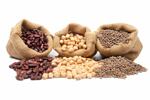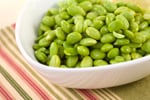The FDA issued draft guidance (click here) on whole grain labeling statements in 2006, but has yet to issue a finalized version, telling FoodNavigator-USA yesterday that it has only just got approval from the Office of Management and Budget to conduct research into consumer understanding of whole grains (click here).
A spokeswoman said: "The study will begin data collection in early 2014. Analysis of data is expected to be finished by the fall of 2014."
In the meantime, a flurry of comments to the docket in the past few months shows key stakeholders disagree over key aspects of the draft guidance, from how to label whole grains, to what they are (click here).
The word ‘grain’ in Latin (granum) means ‘seed’, so “whole grain simply means whole seed “
The 2006 document defines whole grains as “cereal grains that consist of the intact, ground, cracked or flaked fruit of the grains whose principal components - the starchy endosperm, germ and bran - are present in the same relative proportions as they exist in the intact grain.”
Such grains may include amaranth, barley, buckwheat, bulgur, corn (including popcorn), millet, quinoa, rice, rye, oats, sorghum, teff, triticale, wheat, and wild rice, says the FDA. But pearled barley, soybeans, chickpeas and other products derived from legumes, oilseeds and roots should not be considered whole grains.
It is in the public interest to promote consumption of whole seeds…all whole seeds… versus refined or otherwise fractionated seeds
However, Dan Best, president of consultancy Best Vantage Inc - which has extensive experience of working with oilseeds, pulses and legumes - argues that this definition should be expanded to include whole-seed beans, peas, lentils, chickpeas, flaxseed, mustard, sesame, walnut, pine nut, almonds and other whole seeds.
He told FoodNavigator-USA: "I would include ANY whole seeds that include a pericarp in the end-use application. For some seeds (sunflower and soy), it is unlikely that the whole seed would be used, for practical reasons.The objective is to encourage the consumption of the entire seed. If the definition were to be limited to cereals and pseudo-cereals, then at minimum, it should include pulses (beans, chickpeas, lentils, peas) which include significant starch fractions.
“The guiding principle behind developing whole-grain definitions should be based on nutritional, not taxonomic, considerations.”
Besides, the word ‘grain’ in Latin (granum) means ‘seed’, so “whole grain simply means whole seed”, he added, noting that if the FDA is concerned primarily about taxonomy, includingthe ‘pseudo-cereals’ amaranth, buckwheat and quinoa in its whole grain definition isn’t entirely logical, as they are not from the grass family.

In fact they appear to be included because they are used in applications like cereal grains, in which case you could argue that many other seeds and legumes should also be included in the wholegrain definition, he said.
Guiding principle behind developing whole-grain definitions should be based on nutritional, not taxonomic, considerations
And if nutrition is the key, then seeds, pulses and legumes should be at the top of the list, given that flaxseed, chickpea or dry bean flours are more nutritionally rich than many cereal grains, he said.
"The only reason we’re interested in ‘whole grains’ is because the outer layers of the seed are a rich sources of nutrients and removing the bran during milling diminishes its nutritional value. But this is true for all seeds, not just cereal seeds. It is in the public interest to promote consumption of whole seeds…all whole seeds… versus refined or otherwise fractionated seeds.”
ADM: We respectfully disagree with FDA’s narrow definition of whole grain

And he is not alone.
In its comments in the docket ADM said it “respectfully disagree [s] with the agency's narrow definition of whole grain by exclusively focusing on cereal grains” and urged it to include ‘grain legumes’ such as soybeans, which it claimed are “characterized by a bran/seed coat, endosperm and germ” - just like cereal grains - and can also “be utilized also in a manner consistent with other grains”.
Meanwhile, the Northern Crops Institute, Flax Canada and AmeriFlax have also filed comments calling for 'whole grain flaxseed' to be included, with the latter alleging that “FDA has made an improper distinction of whole grain flaxseed by generally categorizing it as an ‘oilseed’ with no other health attributes.”
It added: “Indeed, the nutritional components of whole grain flaxseed compare exceedingly well with cereal grains such as corn, which, in the American diet, functions as much as an oilseed as it does a whole grain.”
There is still time for our industry to contribute to this debate

But isn’t it a bit late in the day to be arguing over definitions?
No, argues Best, who said the FDA had told delegates at the AACCI Annual Meeting in October that it was still accepting comments (Kellogg, General Mills and the CSPI have all filed new comments in the past 6 months although the ‘official’ comment period ended in 2006).
He added: “There is still time for our industry to contribute to this debate. This is still an open question with major consequences for the food industry and consumers alike. Resolution of this issue will determine to what degree non-cereal seeds will be used in many of the new foods currently under development in the US.”
Whole Grains Council: Flax, chia are very healthy, but that doesn't mean they are whole grains
So what does the Whole Grains Council (WGC) think?

Cynthia Harriman, director of food and nutrition strategies at the WGC and Oldways, does not agree with Best’s reasoning.
She told FoodNavigator-USA: “There are many wonderful, healthy foods and ingredients that certainly contribute to better nutrition, but that doesn't mean they are whole grains. The health benefits of whole grains are based on research that does not include oilseeds (flax, chia, sesame, etc.) or legumes/pulses (beans, lentils, soy).
“We're delighted that so many other foods want to climb on the whole grain bandwagon, but we don't think it's appropriate since the health research is tied to cereal grains and the three widely-accepted pseudo cereals (buckwheat, amaranth, and quinoa).
“Instead, we would suggest simply educating the public on the wonderful attributes of oilseeds and legumes so that everyone can appreciate that healthy foods come from many ingredients, not just from whole grains.”
Click here to read more about the areas of the whole grains labeling draft guidance up for debate.
Click here to read recent recent comments from General Mills and click here to read comments from Kellogg on whole grain labeling statements.
Click here to read the FDA's 2006 draft guidance.
